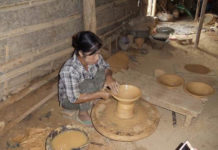Earthenware, known as dau buli or dau tulituli, is a traditional craft originally practiced specifically for making cooking pots and water storage vessels. Dau buli is passed down through generations of women, with a few exceptions of male potters who have shown interest in the craft and developed a more contemporary style.
The original earthenware cooking pots were very large and it took a very fine skill to achieve thin-walled pots that were watertight. Today, the function of dau buli is mostly aesthetic. However, there are villages situated along the Sigatoka river that still fashion a wide mouthed bowl called dari that maintains its traditional use for serving yagona (a drink from the kava plant) and gifting.

Material for dau buli are clay and fine sand. A soaking, straining and mixing method of clay and sand is done over a two-week period to prepare clay. The process used for making dari is the same as done primitively with a round stone and wooden paddle. Dari from Sigatoka has a frilled rim with zigzag or arched patterns etched into the sides using sharp twigs and shell imprints.
After the first firing, the dari are coated with a resin from the local makadre tree. The resin is applied both inside and out creating a gloss finish and making the bowl water resistant.
Kelera Vakili, from the Nawaya village, is a well-known potter. Kelera makes dari for cultural functions in her village. She also creates pottery to order and has supplied several resorts with lamp bases and planters based on her traditional designs. The materials for her craft come from nearby clay pits and fine sand from sand dunes. Both resources are under threat from development and sand mining.
Nawaya village offers a pottery tour in the community hall where visitors can watch demonstrations and purchase wares from Kelera and other village women.





